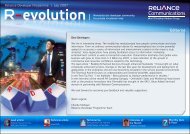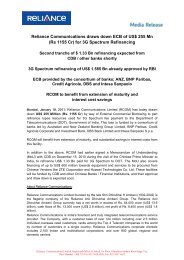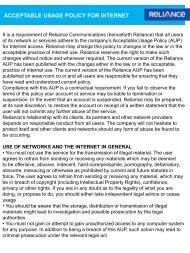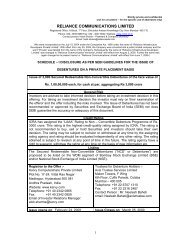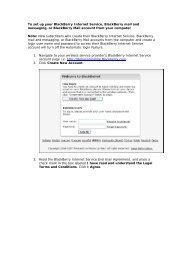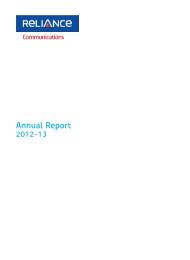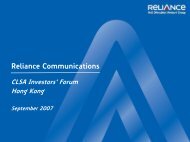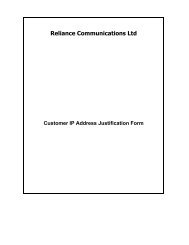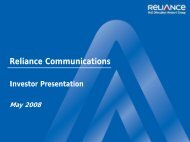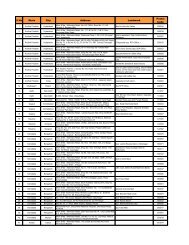3 rd Quarter - Reliance Communications
3 rd Quarter - Reliance Communications
3 rd Quarter - Reliance Communications
Create successful ePaper yourself
Turn your PDF publications into a flip-book with our unique Google optimized e-Paper software.
Operator:Thank you for standing by and welcome to <strong>Reliance</strong> <strong>Communications</strong>’ global earningsconference call on the <strong>Reliance</strong> Audio Conferencing platform.This is Sunita, the moderator for this conference.At this time, all the participants are in listen-only mode. There will be a presentationfollowed by a question and answer session at which time if you wish to ask a question,please press *1 on your telephone. Please be advised, this conference is being reco<strong>rd</strong>edtoday.Today, we have the senior management from <strong>Reliance</strong> <strong>Communications</strong> namely Mr.Punit Garg, Mr. Shamik Das, Mr. Sanjay Behl, Mr. Arvind Narang, Mr. Hasit Shukla andMr. Suresh Rangachar.The call will begin with some key observations by Mr. Punit Garg followed by a questionand answer session. I must remind you that the overview and discussions today mayinclude some forwa<strong>rd</strong>-looking statements that must be viewed in conjunction with therisks that the company faces.I hand over the call now to Mr. Punit Garg. Thank you.Punit Garg:Thank you, Sunita.It is a great pleasure to welcome all of you to this earnings call to discuss <strong>Reliance</strong><strong>Communications</strong>’ financial performance for the quarter ended December 31st 2011.Let me start by sharing the key highlights for the quarter:1. Revenue: RCOM wireless revenue stood at Rs. 4,447 crore, as against Rs. 4,417 crorein Q2, up by 0.7%• RPM: RPM stood steady at a solid 44.6 paisa per minute• EBIDTA: RCOM consolidated EBIDTA margin at 31.9%, amongst the highest in theindustry2. Free Cash Flow and debt management: RCOM continues to be Free Cash Flowpositive in this quarter and this financial year would be the first full year of free-cashflowpositive.2
All major projects have been implemented and peak capex is behind us. Allfuture Capex requirements are only incremental and focused on network quality,capacity, enterprise data center and wireless data growth During the quarter, RCOM tied-up refinancing for redemption of outstandingFCCBs of USD 1.18 Billion, which is due on March 01, 2012. This refinancing isprovided by Industrial and Commercial Bank of China Ltd (ICBC), ChinaDevelopment Bank Corporation (CDB) and Export Import Bank of China (EXIM)and other banks at an attractive interest cost of about 5%. The Company is alsogoing to benefit from extended Loan Maturity of 7 years. This is the largestrefinancing in history of FCCBs by any Indian Corporate. Our aim is to reduce debt significantly by March, 2013.3. 150 Mn. Subscriber Mark: This quarter we have achieved 150 Mn. subscriber markand continue to remain 4th largest wireless operator in the World in terms of singlecountry subscriber base.Financial Performance:Now, I would like to share some of the key highlights of the financial performanceduring the quarter:• Consolidated Revenue at Rs. 5,052 crore against Rs. 5,040 crore (q-o-q)• EBIDTA at Rs. 1,611 crore against Rs. 1,605 crore (q-o-q)• EBIDTA margin at 31.9% is one of the highest in the industry• Net profit of Rs. 186 crore, against Rs. 252 crore (q-o-q)• On the capex front, we have spent Rs. 355 crore during Q3.Let me now brief you on some of the initiatives taken by RCOM, which will have positiveimpact on RCOM’s performance going forwa<strong>rd</strong>:1. Wire Free India: We continue to rapidly execute our ‘Wire-free India’ vision. Wehave remained committed to put accelerated efforts in enabling wirelessbroadband across India. We have expanded our HSD Network and have quality HSDcoverage in almost 1,000 towns up from 65 towns almost one year back.The presence of 3G in 333 towns in 13 circles (including Delhi, Mumbai andKolkata), along with the rapidly expanding High –speed CDMA data network, makesRCOM the only nationwide private operator to offer seamless Wireless Broadbandexperience in over 1300 top towns across the country as of December 31, 2011including key metros.3
Combine this with our extensive 1X Data presence offering high quality internetconnectivity in 20,000 towns; it positions RCOM extremely well to take advantageof the rapid increase in data consumption across the country and enabling ourvision of a ‘Wire Free India’. We currently serve ~ 2.8 Mn 3G active customers onour High Speed Broadband network, highest in the industry.2. <strong>Reliance</strong> <strong>Communications</strong> has always been a pioneer in innovating and re-inventingthe telecom ecosystem in the country. In our endeavor to provide unique valuepropositions to our customers, we launched a true value based product “MeraPlan” across India on both GSM and CDMA platforms. This superior product willprovide most competitive local call tariffs to meet the unmet demands of high localcall users. While providing value for money to the consumer, this plan is an effortto make RCOM’s SIM as a primary SIM in the present multi SIM environment andreduce value churn from existing and new RCOM customers. With this, we intendto increase the realization per customer, build a strong on-net community andincrease customer stickiness to RCOM network.3. The market is witnessing an explosive growth in the Tab market and embracing theroaring success of the <strong>Reliance</strong> 3G Tab, we have hit the sweet spot with a terrificcombination of a fully loaded Tablet and a bundled offer to further enhance valueand customer experience for our 3G customers. Having won accolades andreceived rave reviews from customers, the <strong>Reliance</strong> 3G Tab took the market bystorm with its aggressive price of Rs. 12,999 for a fully loaded tablet bundled withattractive data plans.4. During the quarter, <strong>Reliance</strong> Globalcom has set up world’s first globalMediterranean Gateway and Hub at Cyprus in Europe with the Next Generationsubmarine HAWK cable system. This will enable US and European Multinationalsseeking high speed access to Asia and Middle East. This is going to provideconnectivity to the fastest growing 3G / 4G markets of India, Middle East and Asiacovering 60% of world population to Europe. This is only private cable system withend to end, metro to metro connectivity directly from India and Middle East toEurope with unmatched reliability on 3-diverse cable systems: FEA, FALCON andHAWK.Industry HighlightsDuring the first three quarters of FY12, the industry saw subdued competitive intensityas far as tariffs are concerned and tariff hikes in the recent past by almost all theincumbents is a reflection of the abating competitive pressure on pricing. As mentionedearlier, we have also revised tariffs upwa<strong>rd</strong>s in both GSM and CDMA owing toinflationary pressures on cost. This will certainly help the industry in achieving pricingstability and improving the revenue growth trajectory.4
Overall, in the 3<strong>rd</strong> quarter, the new subscriber acquisitions have slowed down for theIndustry. The industry added 20.77 million wireless subscribers as compared to 22.47million in Q2 and 40.23 million in Q1 of FY12. The total wireless subscriber base as on31st December 2011 stands at 889 million.For RCOM also, subscriber acquisitions have been in-line with the industry in the thi<strong>rd</strong>quarter. We added 2.99 million subscribers in the quarter. RCOM’s total subscriber basestands at over 150 million, maintaining a share of 17% of total customers.Regulatory DevelopmentsLast week, honorable Supreme Court pronounced its judgment cancelling 122 licensesissued after 10th January, 2008. RCOM's licenses are not affected by this judgment asthey were all issued in 2001 or prior.Let me now share with you the financial and operational performance of our wirelessbusiness.• Wireless revenue for the quarter stands at Rs. 4,447 crore, against Rs. 4,417 crore inQ2, up by 0.7%• EBIDTA stands at Rs. 1,182 crore against Rs. 1,176 crore• Our RPM stood at healthy 44.6 paisa, we have successfully arrested decline in RPMfor the last 8 consecutive quarters amidst increasing competition, driven by focus onthe ‘quality of operations’ and recent tariff increase• We have continued our increased focus on data: we now provide high speed datacoverage in over 1,300 towns• We serve ~ 2.8 Mn 3G active customers through our high speed data network.• With this footprint and superior quality network, RCOM leads the 3G data marketspace and would continue to drive this consistently.For the last 9 quarters, the focus has been to build Quality of Operations throughinitiatives focused on segmentation and cluster level profitability. As shared with youduring the previous few quarters, we continue to remain focused on ‘paid minutes’. Thefocus on driving a ‘quality portfolio’ driven by increase in non-voice services hascontinued. Our non-voice revenue contribution to overall revenues is over 20% andamongst the highest in the industry, we target to double the contribution from nonvoicein the next 2 - 3 years.We continued with the discipline of not inducing “free minutes “or FAT, as a result ourRPM has remained healthy at 44.6 paisa/minute. We have further cleaned up our nonprofitable products and tightened acquisition norms to ensure higher retention post 905
days and deliver better customer lifecycle value. Building the on-net community remainsa key focus area. Arresting the decline in CDMA business is a special focus area forRCOM and various programs/initiatives have been lined up for the same. We believethat these initiatives will help RCOM drive profitable growth.RCOM is clearly focused on building a 'healthy portfolio mix', through driving profitableData and VAS businesses thereby future proofing the business against voice led growthalone. This is in line with the trends in the Global telecom markets of building a ‘strongportfolio mix’. Both these segments of Data and VAS are growing at a healthy doubledigit rate. We will continue to provide differential and superior 3G experience tocustomers through our large and superior 3G footprint with speeds upto 28 Mbps.We have already seen tangible evidence of accelerating mobile data adoption whereconsumers and business customers are seizing the benefits of fast, reliable mobile datanetworks using smartphones and other mobile data devices such as Tablets. Asmentioned earlier, the 3G R Tab launched in the last quarter has received greatresponse and to carry forwa<strong>rd</strong> our impetus on “Wirefree India”, we plan to launch theCDMA Tab in the near future.Let me now cover the non-wireless businessesIn our Global Enterprise Business Unit, we achieved revenue of Rs. 2,352 crores ascompared to Rs. 2,335 crore in Q2, a growth of 0.7% and maintained EBITDA of Rs. 569crores for the <strong>Quarter</strong> ending December 31, 2011.Carrier BusinessSecond quarter witnessed strong growth in Carrier business’s sales o<strong>rd</strong>er booking aswell as revenue. We have booked sales o<strong>rd</strong>ers of Rs 512 crores in Q3 FY 2011-12 whichare 15% higher than the sales o<strong>rd</strong>ers signed in Q2. The increase is driven by robustdemand in Europe, Middle East and Asia. We have recently upgraded our FEA (FLAGEurope Asia) and FALCON cable system to add around 1 Tbps of capacity overall acrossdifferent segments to meet the growing demand of capacity in the Middle East and Asia.The International Voice segment continued its robust growth; traffic has grown 17% inQ3 on YoY basis.In the National Long Distance business, we signed o<strong>rd</strong>ers of more than Rs 117 croreprimarily from Bandwidth sales to private service providers.Enterprise BusinessIn India, USA and Europe, we have received sales o<strong>rd</strong>ers of over Rs 417 crores in Q3FY2011-12. Our QoQ success in the government vertical continued as we bagged o<strong>rd</strong>er6
to provide IDC, VPN and Leased line services to Manipur State IDC, Syndicate bank,National Payment council of India and South India Bank among other o<strong>rd</strong>ers. We haveacquired several other new logos in the Enterprise space notable being (i) largestbanking group of UK (ii) One of the world’s leading engineering, architecture andenvironmental consulting company (iii) a full-service, international law firm with officesin the United States, Europe, the Middle East and Asia (iv) US largest innovativesolutions provider for elastomers and thermoplastics.We expect strong and continued growth in the Carrier and Enterprise space from bothIndia and outside India. A strong sales pipeline in the carrier business driven by anincreasing demand of bandwidth in Europe, Middle East and Asia will drive top line andprofitability. India business will continue to focus on winning key o<strong>rd</strong>ers and projects inits key verticals, the Government and Financial services.To summarise:1. We are at the forefront of creating “Wire-free India” by offering seamless wirelessbroadband experience in over 1,300 towns across the country. With more than 20%of our revenues coming from non-voice, we are the largest data player in thecountry. We target to double the contribution from non-voice in the next 2 - 3years.2. We are driving growth of paid minutes and have maintained a healthy RPM3. Maintaining healthy trend in our Global Enterprise business backed by robustdemand for bandwidth, managed services and enterprise outsourcing4. We continue to deliver strong margins at 31.9% EBIDTA and are FCF positive for thequarter and will be FCF positive for the year.To conclude my initial comments, I would like to say that we will continue to strive forinnovation in o<strong>rd</strong>er to offer unique value proposition to our customers in terms ofproduct portfolio, bundled tariff plans, network experience and customer service.Thank you.And I would now like to hand you back for the Q&As.Moderator:Thank you sir. We will open the call for Q&A. We request all of you to focus on keystrategic and business issues. We also request each participant not to ask more thantwo questions and provide an opportunity to other participants to interact with themanagement. Participants now if you wish to ask any question please press * and 1 on7
your telephone keypad and wait for your name to be announced. The first question wehave Srinivas Rao from Deutsche Bank, you may go ahead please.Srinivas Rao:Thank you sir. I have one question rega<strong>rd</strong>ing the wireless business. The minutes growthhas probably been lower than what we have been generally expecting. Please throwsome light on that. Also, your RPM has been stable over last many quarters. I have twoquestions on this. One, what is the outlook for growth in minutes? And second, giventhe tariff hikes which RCOM has followed, can we see the impact of that over the next 2to 3 quarters?Shamik Das:We have steady and healthy, close to 100 billion minutes in this quarter and as we havealready mentioned in last few quarters, we are concentrating on profitable portfolio mixand paid minutes. Our business is generating an RPM of 44.6 paisa per minute and wehave added about 3 million customers this quarter. We have an aggressive plan toexplore the market further especially in our new GSM circles which we had successfullylaunched around 2009. Hence we will see the minutes growing over a period of timebut, our concentration will continue to be on paid minutes to deliver stable RPM.Srinivas Rao:Thank you sir.Moderator:Thank you sir. Next question we have from Gaurav Malhotra from Citigroup. You may goahead please.Gaurav Malhotra:Please explain us the sharp jump in finance charges?8
Arvind Narang:The net finance charges have increased from Rs. 227 crore in Q2 to Rs. 378 crore in Q3primarily due to the effect of net interest cost. The net interest cost on the gross debt issub 5% which translates to approximately Rs. 378 crore.Gaurav Malhotra:Thank you sir.Moderator:Thank you. Next question is from Varun Ahuja from UBS Securities. You may go aheadplease.Varun Ahuja:What is the specific reason for depreciation to come down in this quarter and what canbe expected in the future? Similarly on the Wireless business; EBIT has jumped upsignificantly from the last quarter while depreciation has come down significantly. Whatis the reason for this? And lastly, what is the non-voice percentage contribution?Arvind Narang:Depreciation has reduced by Rs. 76 crore in this quarter on a q-o-q basis. The movementis on account of net impact of three main reasons. Firstly, there is an increase indepreciation because of the first quarter of full impact of the 3G. The second reason fo<strong>rd</strong>epreciation to increase is the NGN project which has been completed and has beencapitalized. Finally, depreciation has reduced significantly due to bringing RTL, one ofthe subsidiary’s depreciation policy in line with the RCOM i.e. to straight line methodwhich was earlier on WDV basis. We have mentioned that in the notes to accounts aswell. The overall net effect of these three reasons is a decrease in the depreciation byRs. 76 crore.9
Shamik Das:I would like to address your question on non-voice revenue. We have the highest nonvoicerevenue contribution in the industry which is ~20% of our revenue, primarily ledby our data revenue which is growing quarter-on-quarter. We have implemented aspecific strategy to grow our data revenue which is based on personalization, richcontent, simplicity and affo<strong>rd</strong>ability. We believe that the data has a huge potential togrow and we are the largest data player in the market having covered about 1,000 citiesfor high-speed data through CDMA and about 333 cities for 3G. We will continue todrive our growth on non-voice data revenue quarter-on-quarter.Varun Ahuja:I just have a follow up to the previous question. In last quarter also you mentioned nonvoicerevenue to be ~20%. Is there any jump in that number or it is still at the samelevel?Sanjay Behl:In the last quarter we had 2.1 million active 3G subscribers on our network which hasgone up in the current quarter to 2.8 million. This is the most accelerated growth ofactivated 3G subscribers amongst any operators and has led to an accelerated growth ofdata. We have seen a reasonably good month-on-month data revenue growth which isahead of voice revenue growth. We are well above 20% on our data revenues with anambition of doubling it in the next 3 years.Varun Ahuja:Where do you book the revenue in tablet, is it in the mobile or the other segmentincome?Sanjay Behl:It is booked in the mobile revenue.10
Varun Ahuja:Thanks.Moderator:Thank you sir. The next question is from Rajiv Sharma from HSBC. Please go ahead.Rajiv Sharma:In the initial remarks you mentioned that you are taking various initiatives to revive theCDMA business. Could you throw some light on that?Shamik Das:CDMA is RCOM’s core business having a very healthy customer base which is deliveringa very healthy data revenue growth through HSD platform across 1,000 towns. We havetaken a couple of initiatives which are helping us to sustain the voice part andexponentially grow the data part of CDMA. Currently there is a choice of about 70handsets available in the market, and to which we have added 7 more handsets in theprice ranging from Rs. 2,000-2,500 up to Rs. 13,000. We are also looking for a high endsmartphone coming into this category. Also, we will be the first operator to launchbranded CDMA tablet in the market very shortly. So the entire ecosystem of devices isbeing actively pursued. Thus, we are doing 2 to 3 specific initiatives at a time, growingthe network and also at the same time enhancing our distribution reach and launchingthe attractive devices for exponentially growing the data part of CDMA.Sanjay Behl:The device lead strategy, which Shamik just talked about, is coming from bothproprietary devices as well as open market devices. Proprietary devices, both in terms ofentry-level handset as well as high end handsets. And there is a the value strategy thatwe are offering. The core of our CDMA business has been built on unlimited callings. Wehave fairly large on-net community and the propositions will be strengthened throughplans like Mera Plan.11
Rajiv Sharma:The last point is somewhat conflicting with your overall strategy of paid minutes. Youare saying unlimited calling but we have seen a cut down in FAT for the last 6 to 8quarters and it continues. Could you help us understand?Sanjay Behl:Actually the strategy is not only on paid minutes but also on the profitable growth ofrevenue, that is the totality of the strategy. The “Mera Plan” pack is adding critical localon-net paid minutes that have the highest retained profitability for the business. Sofrom profitability perspective very high level of margin accrual happens if there is a largeon-net minute being marketed in the system. And there is a fare differential policywhich comes in, which limits unlimited kind of usage of any of the packs and theseobviously come at certain consideration that you have to pay. So, there is an upfrontpayment which itself accounts for usage. So overall, one will have to walk very carefullyas the marketer to balance and blend the portfolio to maintain RPM and also retainedprofitability from the RPM. So it is a fair game that one needs to play.Rajiv Sharma:How much of your revenue comes from CDMA business currently?Arvind Narang:We don't disclose revenue based on the technology. However, the subscriber numbersare already in public domain to consider.Rajiv Sharma:You launched some products in the GSM segment sometime in the end of December2011. How much is the traction on that product and what kind of benefits, can we see inKPI's in the next quarter because of that product?12
Shamik Das:There are many existing plans in the market that offer a similar value proposition. The‘Mera Plan’ offers heavy usage of 500 min of off-net usage which is far higher than ourcurrent off net usage. This plan is actually an effort to make RCOM GSM SIM as theprimary SIM for our new customers in the present multi-SIM scenario. This is theprimary objective to launch such a product to build a much higher level of on-netcommunity and reduce the value churn from the existing and new RCOM customers.This is actually on the line of innovation, which RCOM keeps on offering to the marketand create a different market segment which actually induces higher level of usage aswell as get retained within our network. With this plan, we intend to build a strong onnetcommunity and increase customer stickiness. We have got an excellent responsefrom the market; not only from the customers but also from the retailers anddistribution community. This product is also delivering healthy ARPU.Rajiv Sharma:Could you give us the number of towers which are on both GSM and CDMA, and thenumber of 3G BTS?Arvind Narang:Our captive tenancy is around 1.5x. Tenancy of 0.5x comes from CDMA on our total baseof around 50,000 towers while our total tenancy is around 1.85x. The rest comes fromthi<strong>rd</strong> parties. We are providing 3G services in about 333 towns through 11,000 sites.Rajiv Sharma:Thank you very much.Moderator:Thank you very much sir. Next question is from Vivekanand from MF Global. Please goahead.13
Vivekanand:I had a query on the 3G data trends. What is the average active user’s 3G monthly dataconsumption and what would be the incremental ARPU? What is the Capex guidance forFY13?Sanjay Behl:On the 3G data we are seeing ARPUs in the range of Rs. 500-600. That is the blendedARPU of a pre-and post-paid user today with a postpaid user closer to the range of Rs.800-1,000 and prepaid at about Rs. 250-350. The data usage is in the range of 800 MB to1GB.Vivekanand:What would be the incremental ARPU on account of 3G for these users; incrementalover the voice ARPU?Sanjay Behl:That would be about 2.5x-3x times, on the blended ARPU.Vivekanand:Sir if I understand that correctly, these users would typically be Rs. 300 voice ARPU usersand over and above that they would be using dataShamik Das:The factor of 2.5x–3x mentioned is with respect to average ARPU and not for anyspecific segment.Arvind Narang:The Capex guidance for this fiscal year is Rs. 1,500 crore and we are on track. Our Capexguidance for the next year will be provided in Q4. It will remain low as the peak of capexintensity is already behind us which we have stated earlier also.14
Vivekanand:Thank you sir.Moderator:Next question is from Amar Mourya from IndiaNivesh Securities. You may go aheadplease.Amar Mourya:I have one book keeping question. Why the financing charges have gone up in thisquarter?Arvind Narang:As mentioned earlier, the net finance charges have increased from Rs. 227 crore in Q2to Rs. 378 crore in Q3 primarily due to the effect of net interest cost. The net interestcost on the gross debt is sub 5% which translates to approximately Rs. 378 crore.Amar Mourya:Thank you sir.Moderator:Thank you. The next question is from Anirban Roy from Morgan Stanley. You may goahead please.Anirban Roy:What is happening on the tower sale for your Company? Why is there a decline in traffictrends and when do you see it growing?Shamik Das:We will take the second question first. This quarter, our total voice minutes have grownby about 1% to 100 billion minutes. The traffic is of two types - one is voice traffic andthe other one is data traffic. Voice traffic is currently going through some rationalizationhowever we are continuing with the profitable mix of portfolio strategy and maintaining15
the paid minute growth. But in data, we are seeing tremendous growth coming in,mostly in HSD data portfolio. Gradually, we are also seeing traction coming in on 3Gtraffic. We believe that the industry will continue to grow in traffic and RCOM will alsogrow its traffic.Anirban Roy:Could you give us some numbers on that may be for the next quarter and the next year?Shamik Das:We will not be able to give a forwa<strong>rd</strong>-looking statement but if you see our recent trafficpattern, our total MOUs have grown.Anirban Roy:Voice traffic for one of your competitors was much higher. So what is actually keepingyours down?Punit Garg:The ‘Mera Pack/Mera Plan’ which we mentioned earlier has already started showinggood results. Hence, the traffic has started increasing. We have received very goodresponse from customers and from retailers, and distributors as well.Arvind Narang:Tower sale is progressing well but we won't be able to share any specifics at this stage.We will provide the details at an appropriate time.Anirban Roy:All right, thank you.Moderator:Thank you sir. Next question is from Shobit Khare from Motilal Oswal Securities. Youmay go ahead please.16
Shobit Khare:Good evening and thank you for the opportunity. I have three questions; One, could youshare what has been the growth in the dongle business and how the growth has beenafter launch of 3G services this year? Second, what could be the revenue as well as costimplication of the licenses which have been cancelled? How is RCOM exposed to someof these new operators? And thi<strong>rd</strong> is on the GSM spectrum. Does RCOM plan to bid formore spectrums after this recent judgment? RCOM is still having 4.4 MHz, so what is thepath going forwa<strong>rd</strong> for further spectrum in the GSM business?Shamik Das:Rega<strong>rd</strong>ing the 2G spectrum auction question; RCOM holds Pan India CDMA at 800 MHzand GSM at 900 MHz & 1,800 MHz spectrum. Additionally, RCOM has won spectrum for3G in 13 circles in 2,100 MHz band. It is our endeavor to provide unmatched networkexperience coupled with wider choice of technology to our 150 million plus customers.At the same time, we also want to maximize return to our shareholders. To achieve thestated object we would like to take a call once the spectrum comes for auction anddetailed guidelines are announced.Punit Garg:On the second question rega<strong>rd</strong>ing the impact of 122 license cancellation on RCOM, wecurrently do not see any impact on our business.Sanjay Behl:On the dongles side, it is clearly visible that the competitive intensity in the space hasgone up with incumbent GSM operators now coming with the offerings on 3G. In anyindustry, the competitive intensity goes up when the rate of growth starts to accelerate.We have been seeing this acceleration in the data space which is a good news for usbecause we are market leaders in data which manifests itself from the fact that we havethe largest distribution footprint as far as number of towns is concerned and offerwidest choice of access devices. So overall, we are seeing heightened activity and17
competitive intensity, leading to an accelerated market growth. And RCOM hascontinued to enjoy the market share of this accelerated market space. We will not ableto share specific numbers at this point of time but overall we expect that this market isgoing to more than double in the next 3-5 years.Shobit Khare:Thanks a lot and all the best.Moderator:Thank you. The next question is from Sachin Salgaonkar from Goldman Sachs. You maygo ahead please.Sachin Salgaonkar:I have two questions Sir. Firstly, post license cancellation notice; is RCOM seeingsubscribers of these new operators trying to port-out and with that respect, do youhave any strategy on targeting some of it like, raising some distribution commissions oractively targeting them to port-in to your network? Secondly, when I look at your capexspend for the last few quarters and compare it with the other listed operators, yourcapex is significantly lower than others which also gets translated into slightly lowerrevenue market share (RMS) or the loss of RMS, which we are seeing for few quarters.Does RCOM see this trend reversing where your capex investments pick up on a YoYbasis and hence may be getting reflected into a RMS increase also? Thank you.Shamik Das:For RCOM, the business is as usual. As the competitive intensity will continue in themarket, there is no change in customer acquisition plan or program by RCOM so far.Coming to the second point, on capex investments vis-à-vis RMS, already theinvestments have been made on different technologies whether it is 3G, 2G, CDMA,data as well as voice and we don't need to immediately invest in enhancing thenetwork. In case of HSD data, during the last one year, we have expanded from 6518
towns to 1,000 towns and going forwa<strong>rd</strong> we may expand it further. Our current capexoutlook on voice front is that we don't envisage further investment immediately.Sachin Salgaonkar:Sir, just a follow-up on that one. When I am basically looking at your capex spend onyearly basis and on a quarterly basis even after 3G licenses were given couple of yearsago, I don't really see the capex picking up that much. What kind of investments are youtalking on WCDMA platforms since you got 3G? Sir, if you could throw a color on howmany Node Bs are you having or what's your population coverage on WCDMA basis visà-visyour 2G coverage?Punit Garg:On 3G side, the total capex incurred was about Rs. 10,500 crore which includedspectrum payment plus the capex on equipment. If you refer to TRAI Quality of Service(QoS) reports with respect to RCOM, in five circles we are the clear leader and in othercircles, we are among the top three players. This was possible as we have investedsufficient capital expenditure in our pan India 2G network. When we rolled pan IndiaGSM network out in 2009, it was 3G ready and with minimal additional capex we wereable to launch 3G services. In case of other operators, considering the ageing of theassets, they have to replace some of the equipments which are already 12 -13 years old.But, in our case, GSM being a newer rollout, our capex investment would be much lowerfor next few years as we do not have a replacement cost which is required.Sachin Salgaonkar:Thank you sir.Moderator:Thank you. The next question we have from Reena Verma from Merrill Lynch. You maygo ahead please.19
Reena Verma:Just a few questions, firstly from the housekeeping perspective. Your network costappears to have shown a significant jump but all your divisional margins are fairly stable.I just wanted to know what is the increase in network cost attributable to and for whichdivision? Also, Arvind you said that the rise in finance charges is due to net interest costrising. Can you just elaborate what you really mean? Does it mean that the interestincome shrunk because your debt levels have not moved up that much? And just on thestrategy front, if you could share with us your outlook on tariff going forwa<strong>rd</strong>,particularly in light of comments by some of your competitors and also the recentconsultation paper from TRAI, how are you thinking about tariff? Thank you.Arvind Narang:I will take your first two questions, on network cost and on the interest cost. Thenetwork cost has gone up by around Rs. 121 crore in this quarter primarily on account ofthree reasons. One, there was a major fiber cut, which has happened on our Flagsubmarine cable network, which is a one-time cost. Second, there was some additionalmaintenance costs being provided in the Flag and thi<strong>rd</strong> is that this is the first quarter forthe full 3G sites. However, the network cost is in line over a period of time. If you seethe network cost for the last 8 to 10 quarters it has been in the range of Rs. 1,350-1,500crore and in this quarter it is Rs. 1,495 crore, which is in the same range as mentioned.Reena Verma:Sir, how much is the one-time cost for Flag fiber cut?Arvind Narang:One-time cost is, approximately, Rs. 90 crore. Rega<strong>rd</strong>ing the finance charges, the wholeeffect is because of the net finance charge. In the last quarter, there was a modestinterest income and that is why there is a difference. But if you look at the currentnumber i.e. Rs. 378 crore and see in terms of the cost of debt on our gross debt you willfind this is in the same range, which we have been saying as less than 5%.20
Reena Verma:Sir, this level of interest expense of about Rs. 3.8 billion, is it sustainable level for thenext 2 quarters?Arvind Narang:Yes, it is likely to be in this range.Reena Verma:Thank you sir.Shamik Das:Coming to your question on tariff, a couple of months back, there was an increase intariff. The major reasons being the inflationary pressure on cost and the increase ininput cost. But we didn't see much elasticity post increase of the tariff and we see thatthe market has accepted this tariff hike. We will evaluate how the telecom industry isevolving from here now and take a decision acco<strong>rd</strong>ingly.Reena Verma:Does that mean that you will be happy to participate in tariff cuts, if we see that?Shamik Das:We will observe and see how the other players in the industry are reacting to that andthen we will take our decision acco<strong>rd</strong>ingly.Reena Verma:Thank you sirModerator:Thank you. Next question is from Srinivas Rao from Deutsche Bank. You may go aheadplease.21
Srinivas Rao:I wanted to check with the level of margins, which is generally higher than the otherplayers but, there is a modest increase too. Given that your revenue share has generallyeither been stable-to-falling over the last four quarters, how do you explain an increasein your margins, and the fact that you have three network technologies to work with?Finally, please help us understand the improvement in margins in this quarter?Punit Garg:Is your question at RCOM level or on the business segment level?Srinivas Rao:The particular question pertains to your wireless business. It is bit surprising that despitehaving three networks and they being larger than what we assumed in the synergy inthe networks, the revenue shares have not changed much and your minutes growth hasnot been significant to give any economies of scale over the last couple of quarters?Arvind Narang:One of the biggest reasons for more profitable business model is our non-voice businesswhich is largely driven by the data, CDMA, 1X, EVDO as well as 3G. All these are muchhigher in proportion versus any other player in the country. Also, the incrementaleconomics of this (data) business is extremely profitable. We have already incurred allthe costs whether they are on the utility side, the staff side, SG&A or in any other lineitem. So the incremental economics becomes much stronger. Moreover, operators don'thave to pay any access charge / IUC for the data which exists in the voice business. Sothe profitability on an incremental basis is comparatively higher, especially when youare already profitable on that segment. This helps us to maintain or even improveprofitability even if the revenue growth was marginal.Shamik Das:We have a healthy mix of data in our total revenue pie. We have also mentioned thatwe have about 20% non-voice based revenue. Monetization of the capex investment is22
also taking place through the usage. So all put together, we could deliver one of thehighest operating margins in the industry.Sanjay Behl:You should also consider the on-net community because we have the second largestwireless subscriber base in the country with over 150 million subscribers. Combinationof our data, retained margins, added to a very large on-net community. This leads to theoverall margin profile being competitively on the top of the deck.Srinivas Rao:Sir, this is the follow-up. We do get the share of on-net calls, TRAI releases the dataevery quarter. Would it be fair to say that your share of on-net calls is higher than theindustry average which TRAI reports?Arvind Narang:It could be in line with the industry. Given that our on-net community is larger, we getbenefited a little more, but the percentage would be same.Srinivas Rao:Thank you.Moderator:Thank you sir. At this time there are no further questions from the participants. Thatdoes conclude the conference call for today. Thank you for participating. You may alldisconnect now. Thank you.23




